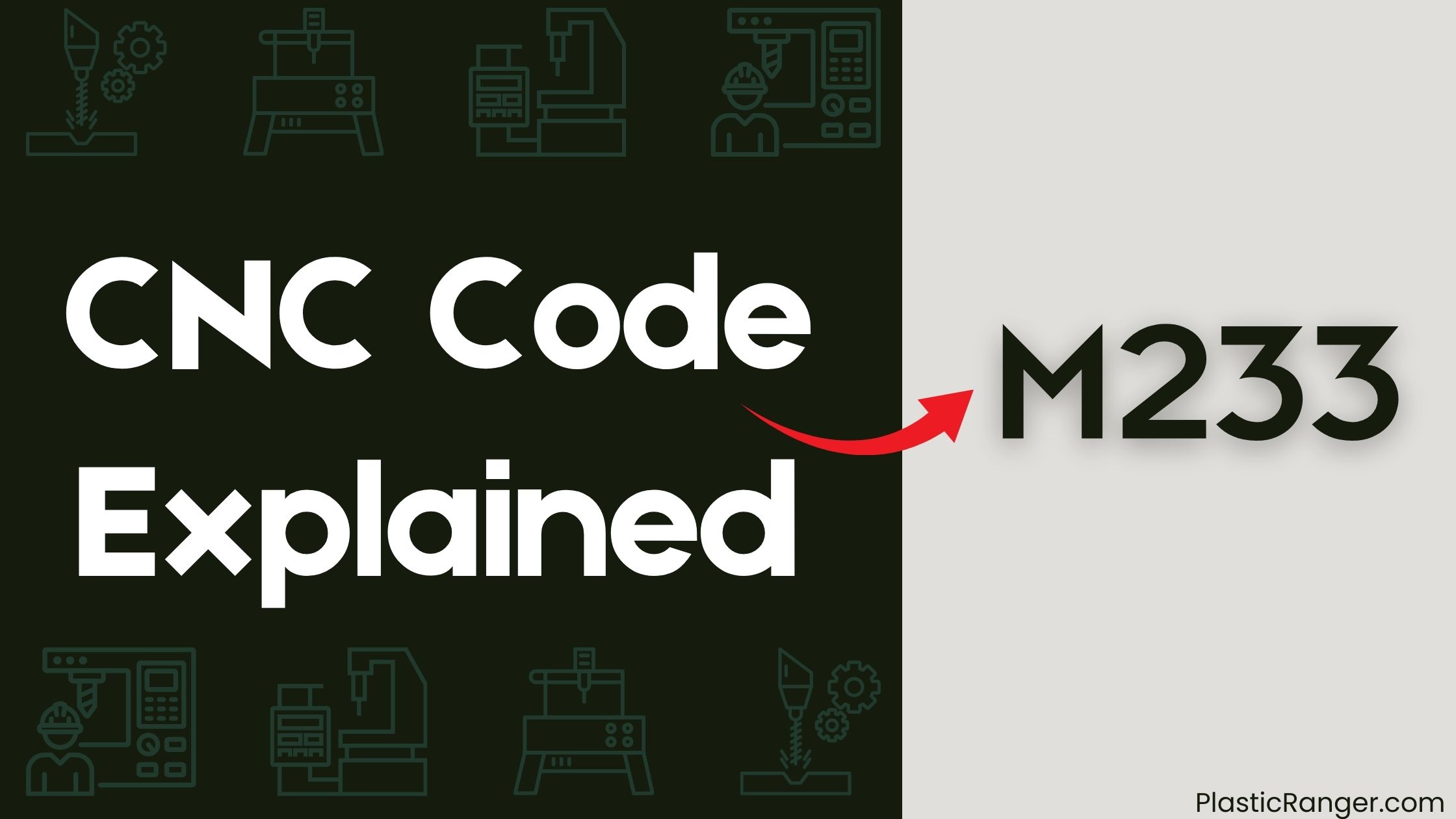Welcome to our simple guide on the M233 CNC code. Whether you are new to CNC programming or an experienced machinist, understanding the M233 code is essential.
This guide will explain everything you need to know about this unit mode command—what it is, when to use it, and why it matters.
(Step-by-step.)

Key Takeaways
- M233 CNC code’s function varies depending on the machine builder and configuration, requiring consultation of machine-specific manuals.
- M233 may control spindle orientation or coolant control, but implementation differs between manufacturers and machines.
- Testing and validating M233’s functionality on the target machine is crucial before using it in production to prevent errors.
- Proper understanding and testing of M233 prevent unexpected behavior or damage to the machine or tools.
- M233 is an M-Code that controls machine functions, and its availability and syntax may vary by machine and manufacturer.
Understanding M233 CNC Code
When working with CNC machines, understanding the M233 code is crucial to guarantee accurate and efficient production.
As a programmer, you’ll need to consult machine-specific manuals to grasp the code’s function, as it varies depending on the machine builder and configuration. You might use M233 to control spindle orientation or coolant control, but its implementation differs between manufacturers like Fanuc, Siemens, or Heidenhain.
To avoid errors, you must understand the code’s behavior in your machine’s configuration. Don’t rely on universal definitions, as they don’t exist. Instead, test and validate M233’s functionality on your target machine before using it in production.
With proper understanding and testing, you’ll verify correct operation and prevent unexpected behavior or damage.
M-Codes and G-Codes Explained
In the world of CNC machining, you’re likely to encounter two types of codes: M-Codes and G-Codes.
These codes work together to create a comprehensive CNC program.
M-Codes control various machine functions, such as:
- Tool management
- Spindle control
- Coolant control
G-Codes, on the other hand, specify the actions of a CNC machine, including movement, drilling, and cutting.
They define the actual machining process.
Understanding the difference between M-Codes and G-Codes is vital for creating effective CNC programs and ensuring accurate machine operation.
The availability of M-Codes and G-Codes varies by machine and manufacturer, so it’s essential to consult machine-specific manuals for accurate codes.
CNC Syntax Editor Features and Capabilities
You’ve mastered the basics of M-Codes and G-Codes, and now you’re ready to take your CNC programming to the next level with a powerful tool: the CNC Syntax Editor. This Editor software supports syntax highlighting for all G code or M codes, making it easier to write and debug CNC programs. It also offers real-time data monitoring and logging capabilities, allowing you to track and analyze your CNC machine’s performance.
| Feature | Capability |
|---|---|
| Syntax Highlighting | Supports all G and M codes |
| Real-time Data Monitoring | Logs and tracks CNC machine performance |
| Communication Protocols | Works with MODBUS RTU/TCP/ASCII |
| Code Editing and Debugging | Adds tooltips with comments for each code |
| Availability | Available in trial or FREE version for download |
MODBUS Software and Serial Data Logger
MODBUS Software and Serial Data Logger serve as powerful tools for monitoring and logging serial data from your CNC machine or other serial devices.
With these tools, you can efficiently collect and log data from various serial devices and instruments.
- MODBUS software supports RTU, TCP, and ASCII protocols for real-time data monitoring and logging, and can work as both master and slave.
- The software enables inputting data directly into a file, Excel, Access, or any Windows application, providing real-time data collection from any serial device or instrument.
- Advanced Serial Data Logger functions allow inputting RS232 data directly into a file, Excel, Access, or any Windows application, offering advanced serial data logging capabilities.
- The software can work with various serial devices and instruments, enabling efficient data collection and logging.
- AGG Software develops MODBUS software and Advanced Serial Data Logger, providing a comprehensive solution for serial data logging and monitoring.
Machine Control and Tool Management
While controlling a CNC machine, you need to manage tools and machine functions efficiently to guarantee accurate and precise operations.
M-Codes play a vital role in this process, controlling various machine functions and tool management. To change a tool, you use the M06 code, which swaps the current tool with another.
You can also control the spindle rotation using M03, M04, and M05 codes, which start the spindle clockwise, counterclockwise, and stop it, respectively.
Additionally, M-Codes M07, M08, and M09 manage coolant flow, turning mist coolant on, flood coolant on, and turning both off, respectively.
With software that supports syntax highlighting, you can easily identify and manage these M-Codes, ensuring efficient machine control and tool management, which is essential to the operation.
CNC Codes Similar to M233
| Code | Mode |
|---|---|
| M230 | Tool length offset direction; Used as it is |
| M231 | Tool length offset direction; Used after reversing the direction |
| M232 | 3D tool length offset direction; Used as it is |
| M234 | Synchronized tapping gear selection: Low, Middle low, Middle high, High |
| M235 | Synchronized tapping gear selection: Middle low, Middle high, High |
| M236 | Synchronized tapping gear selection: Middle high, High |
| M237 | Synchronized tapping gear selection: Middle high, High |
| M238 | Software override invalid |
| M239 | Software override valid |
| M331 | Spindle coil change fixed to high speed |
| M332 | Spindle coil change, valid |
| M41 | First Gear Selection/Change |
| M42 | Second Gear Selection/Change |
| M43 | Third Gear Selection/Change |
| M44 | Fourth Gear Selection/Change |
| M45 | Fifth Gear Selection/Change |
Quick Navigation
